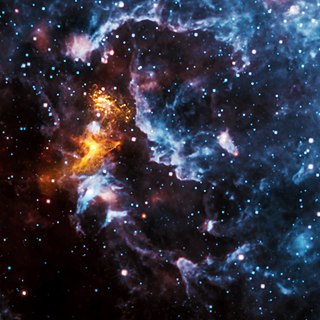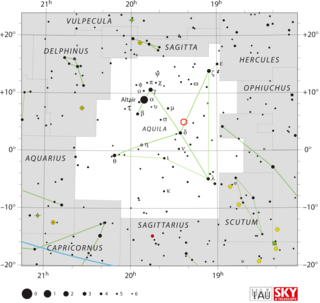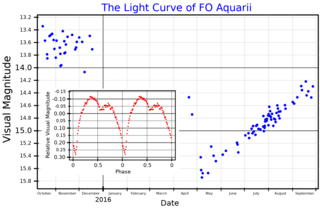
A pulsar is a highly magnetized rotating neutron star that emits beams of electromagnetic radiation out of its magnetic poles. This radiation can be observed only when a beam of emission is pointing toward Earth, and is responsible for the pulsed appearance of emission. Neutron stars are very dense and have short, regular rotational periods. This produces a very precise interval between pulses that ranges from milliseconds to seconds for an individual pulsar. Pulsars are one of the candidates for the source of ultra-high-energy cosmic rays.

Delta Aquarii, officially named Skat, is the third-brightest star in the constellation of Aquarius. The apparent visual magnitude is 3.3, which can be seen with the naked eye. The distance to this star is about 113 light-years based upon parallax measurements, and it has a close companion.

Beta Aquarii is a single star in the constellation of Aquarius. It has the official name Sadalsuud and the Bayer designation β Aquarii, abbreviated Beta Aqr or β Aqr. Based upon parallax measurements obtained during the Hipparcos mission, this component is located at a distance of approximately 540 light years (165 parsecs) from the Sun. It is drifting further away with a radial velocity of 6.5 km/s. The star serves as an IAU radial velocity standard.

Xi Aquarii is a binary star system in the equatorial constellation of Aquarius. It is visible to the naked eye with an apparent visual magnitude of 4.7. Based upon parallax measurements made during the Hipparcos mission, this system lies at a distance of around 179 light-years from the Sun.

V1494 Aquilae or Nova Aquilae 1999 b was a nova which occurred during 1999 in the constellation Aquila and reached a brightness of magnitude 3.9 on 2 December 1999. making it easily visible to the naked eye. The nova was discovered with 14×100 binoculars by Alfredo Pereira of Cabo da Roca, Portugal at 18:50 UT on 1 December 1999, when it had a visual magnitude of 6.0.

91 Aquarii is the Flamsteed designation for a triple star system in the equatorial constellation of Aquarius. It also bears the Bayer designation Psi1 Aquarii. It is visible to the naked eye with an apparent visual magnitude of +4.248. Parallax measurements yield an estimated distance of around 150 light-years from Earth. An extrasolar planet is known to orbit the main star.

Iota Aquarii, Latinised from ι Aquarii, is the Bayer designation for a binary star system in the equatorial constellation of Aquarius. It is visible to the naked eye with an apparent magnitude of +4.279. Based upon parallax measurements made during the Hipparcos mission, the distance to this star is around 175 light-years. The system is drifting closer to the Sun with a radial velocity of −10 km/s.

Pi Aquarii, Latinized from π Aquarii, is the Bayer designation for a binary star in the equatorial constellation of Aquarius. This system has an apparent visual magnitude of a mean apparent magnitude of +4.57. Based upon parallax measurements, it is located at a distance of roughly 780 light-years from Earth. It is drifting further away with a radial velocity of +4 km/s.
104 Aquarii (abbreviated 104 Aqr) is a star in the equatorial constellation of Aquarius. 104 Aquarii is the Flamsteed designation, although it also bears the Bayer designation A2 Aquarii. Based on an annual parallax shift of only 3.89 ± 0.25 milliarcseconds, the distance to this star is about 840 light-years (260 parsecs). At that range, the brightness of the star in the V-band is reduced by 0.10 magnitudes as a result of extinction caused by intervening gas and dust.

1 Aquarii is a binary star system in the zodiac constellation of Aquarius, about 257 light years away from the Sun. 1 Aquarii is the Flamsteed designation. It is visible to the naked eye as a faint, orange-hued star with an apparent visual magnitude of 5.151, located a degree north of the celestial equator. The system is moving closer to the Earth with a heliocentric radial velocity of −41 km/s.

53 Aquarii is a binary star system in the equatorial constellation of Aquarius. 53 Aquarii is its Flamsteed designation though the star also bears the Bayer designation of f Aquarii. The combined apparent visual magnitude of the pair is a 5.56, making it just visible to the naked eye in dark suburban skies. Based upon an annual parallax shift of 49.50 milliarcseconds for the first component, this system is located at a distance of approximately 65 light-years from Earth.
44 Aquarii is a single star located 336 light years away from the Sun in the equatorial constellation of Aquarius. 44 Aquarii is its Flamsteed designation. It is visible to the naked eye as a dim, yellow-hued star with an apparent visual magnitude of 5.75. This body is moving away from the Earth with a heliocentric radial velocity of +7.4 km/s.
15 Aquarii, abbreviated 15 Aqr, is a single, blue-white star in the zodiac constellation of Aquarius. 15 Aquarii is the Flamsteed designation. It is a dim star that is just visible to the naked eye under good viewing conditions, having an apparent visual magnitude of 5.83. Based upon an annual parallax shift of 4.6 mas, it is located around 710 light years away. At that distance, the visual magnitude is diminished by an extinction of 0.18 due to interstellar dust. It is moving closer to the Earth with a heliocentric radial velocity of −9 km/s. Relative to its neighbors, 15 Aqr has a peculiar velocity of 28.7+2.9
−3.1 km/s and may be a runaway star.
60 Aquarii is a star located 375 light years away from the Sun in the equatorial constellation of Aquarius. 60 Aquarii is its Flamsteed designation. It is visible to the naked eye as a dim, yellow-hued star with an apparent visual magnitude of 5.89. The star is moving closer to the Earth with a heliocentric radial velocity of –8 km/s.
11 Aquarii is a sun-like star in the zodiac constellation of Aquarius, located 88.5 light years away from the Sun. 11 Aquarii is the Flamsteed designation. It is difficult to see with the naked eye, appearing as a dim, yellow-hued star with an apparent visual magnitude of 6.22. This body is moving closer to the Earth with a heliocentric radial velocity of −17.8 km/s, and is expected to come as close as 65.1 ly in 700,000 years.

R Aquarii is a variable star in the constellation Aquarius.

FO Aquarii is an intermediate polar star system in the constellation Aquarius. The white dwarf and companion star orbit each other with a period of approximately 4.85 hours. The system is famous for a very strong optical pulsation which occurs every 20.9 minutes, corresponding with the rotational period of the accreting white dwarf. Prior to 2016, the system's long-term optical brightness varied between apparent magnitude 12.7 and 14.2, but in early 2016, it faded to magnitude 15.8 and thereafter began a slow recovery to its normal brightness, behavior which is indicative of a temporary dropoff in the mass-transfer rate between the two stars.

HU Aquarii is an eclipsing binary system approximately 620 light-years away from the Sun, forming a cataclysmic variable of AM Herculis-type. The two stars orbit each other every 2.08 hours and the ultra-short binary system includes an eclipsing white dwarf and red dwarf.

AR Scorpii is a binary pulsar that consists of a white dwarf and a red dwarf. It is located close to the ecliptic plane in the constellation Scorpius. Parallax measurements made by Gaia put the system at a distance of about 380 light-years.

HK Aquarii is a single variable star in the equatorial constellation of Aquarius. It is invisible to the naked eye, having an average apparent visual magnitude that fluctuates around 10.99. The star is located at a distance of 81 light years from the Sun based on parallax. The radial velocity is poorly constrained but it appears to be drifting further away at a rate of ~2 km/s.









